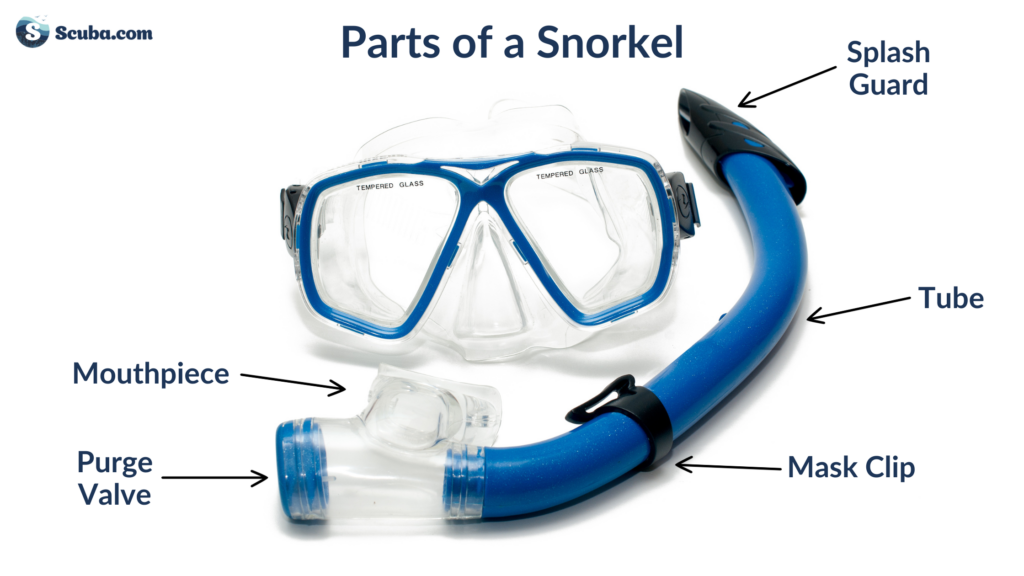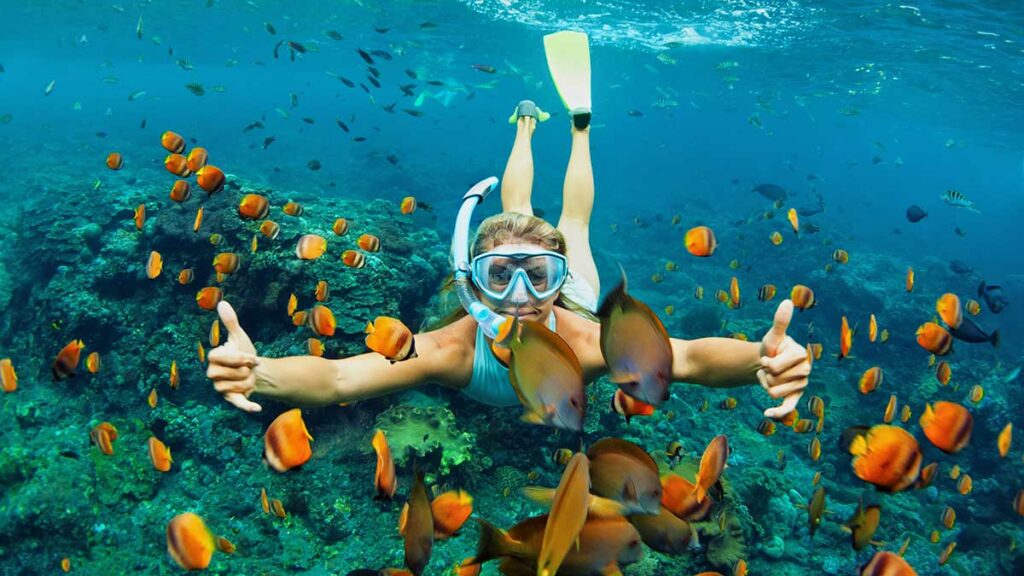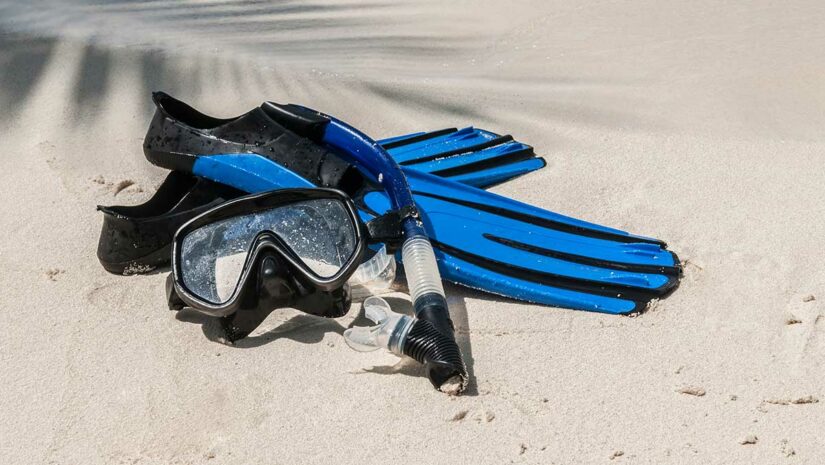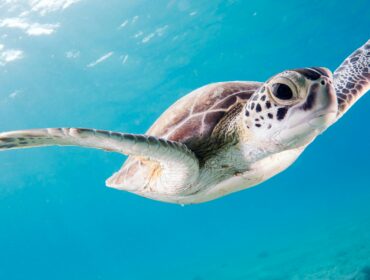Have you ever imagined yourself drifting effortlessly amid colorful corals, playful fish, and the enchanting dance of sunbeams in crystal-clear waters? Dive into the captivating underwater realm of snorkeling where such fantasies become reality. One of the charms of snorkeling is its simplicity — no formal certification needed! Compared to its deeper cousin, scuba diving, snorkeling is a breeze to pick up, and the wonders it offers are just as spectacular.
Eager to make a splash? Our handpicked guide on top-tier snorkel picks will ensure that you’re prepped and ready for your aquatic escapades!

Key Components of a Snorkel
Tube: The Breathing Lifeline
Picture this as your personal above-water air channel. It’s your primary connection to that lovely, breathable atmosphere while your face is submerged in the ocean’s wonders.
Material & Design
Typically made from durable plastic or silicone. The tube’s curvature, length, and diameter are carefully engineered to maximize your comfort and ease of breathing.
Fun Fact
The snorkel’s length is crucial. Too long, and it becomes difficult to exhale fully, potentially leading to a buildup of carbon dioxide.
Mouthpiece: Where You Meet the Snorkel
Think of it as a handshake (or perhaps a lip-lock?) between you and your snorkel. This is the bit you’ll be getting quite familiar with.
Material
Crafted from soft, body-friendly silicone, it’s designed to be gentle on your mouth, minimizing any jaw fatigue during prolonged use.
Pro Tip
If you’re a frequent snorkeler, it might be worth investing in a personalized or ergonomic mouthpiece for that perfect fit.
Mask Clip or Snorkel Keeper: The Trusty Sidekick
This unsung hero ensures your snorkel stays by your side (or rather, by your face), attached securely to your mask.
Functionality
It’s not just about keeping the snorkel in place; a good mask clip allows for easy adjustments, ensuring your snorkel is positioned just right.
Did You Know?
Some high-end snorkels come with a quick-release function, making it a breeze to attach or detach your snorkel without any fuss.
Purge Valve: The Handy Exit Door
Conveniently located near the mouthpiece, this little gem allows any sneaky water that’s entered your snorkel to make a swift exit.
How it Works
If a bit of water trickles in, a strong exhale will push the water out through the purge valve. It’s like having a mini drain at the bottom of your snorkel.
Maintenance Alert
It’s essential to keep this valve clear of debris. A stuck valve can hamper its functionality, so giving it a rinse and check after every snorkeling session is a good practice.
Splash Guard or Top Valve: Your Personal Water Bouncer
Located at the top of your snorkel, its main job is to prevent or minimize water from making an unwelcome entrance.
Types & Functionality
While a splash guard deflects surface splashes, a top valve in dry snorkels seals completely upon submersion, ensuring zero water entry.
Little Known Fact
This feature is especially handy in choppy waters, where unexpected waves and splashes are common.
Flex Section: Bend It Like… A Snorkel?
This bendy part near the mouthpiece gives your snorkel some flexibility. It allows the snorkel to drop away from your face when you’re not using it.
Why It’s Cool
It provides additional comfort, especially if you alternate between snorkeling and simply floating or chatting with your snorkel buddy.

Types of Snorkels
Snorkels may appear similar to someone with little knowledge, but they have evolved over time, and there are now various types to suit different needs.
Here’s a deep dive into the types of snorkels: classic snorkel, flexible snorkel, semi-dry snorkel, dry snorkel and full-face snorkel. Each of these types have various styles, sizes, hardness and features that will make a better choice for certain skillsets and activities.
The Classic “J” Snorkel
Let’s start with the most basic and recognizable snorkel – the classic snorkel or the “J” snorkel. Ever wonder why it’s called that? Well, its design mirrors the shape of the letter J. It’s straightforward, no-fuss, just a plastic tube paired with a mouthpiece. It’s simple, durable and effective.
Many free-divers and spearfishers favor the J snorkel because it offers minimal drag, letting them dive deep into the ocean’s wonders after a single breath. Since the tube is open at the top it will fill up entirely with water, requiring the diver to “blast” the snorkel to clear it once reaching the surface. It’s not just limited to ocean explorers, though. Those training for competitive swims, especially triathlons, find it a helpful training companion due to its low resistance in water.
If you’ve ever used rental snorkeling equipment, chances are you’ve come across the classic J snorkel. The simplicity of the classic snorkel makes it popular with the beginners but they need to be careful of swallowing and choking on ocean water. They generally cost less than their fancier counterparts and are the most affordable option out there.
Flexible Snorkel
Unlike their more traditional counterparts, flexible snorkels are crafted from soft silicone and can bend easily. They typically have a rigid portion and a flexible portion. A flexible type tubing near the mouthpiece allows for greater head movement. They can also bend away from obstacles underwater or drift away from your face when you’re submerged. Casual snorkelers prefer this feature as it gives greater flexibility to their range of motion and makes the mouthpiece feel a bit more comfortable.
The purge valve at the bottom flushes out excess water every time you exhale. This ensures even and uninterrupted breathing. However, it is important to note that if a particulate matter like sand or dirt gets stuck in the bottom purge valve, the tube can become blocked.
Its adaptability makes it perfect for deep dives and adventurous pursuits like navigating underwater caves. But like the classic snorkels, the flexible snorkels have nothing on the top of the tube to keep water out. That means when you submerge, it is going to fill with water and you will need a hard exhale to remove water from the tube once you emerge.
Semi Dry Snorkel
The semi-dry snorkel combines the straightforwardness of a classic snorkel with the enhanced protection of a dry snorkel. It is designed to keep water out of the tube. A lot of semi dry snorkels also come with a flexible tube.
Semi dry snorkels have a splash guard at the top and a purge valve at the bottom to clear out the water. Splash guards are designed to channel the water away from the top of the tube and thus reduce the amount of water that goes into the snorkel and require clearing out before breathing. This ensures that you get a mostly dry experience.
While it is great at guarding against casual splashes, if you dive completely under the waves, or find yourself beneath a more sizable wave, the pipe will fill up with water. Many semi-dry snorkels come equipped with handy one-way purge valves. This makes flushing out water easier.
Some of the purge valves and splash guards work with a moving mechanical device, which is not ideal if a grain of sand or small particulate gets stuck, causing the mechanism to break or leak.
Dry Snorkel
Dry snorkels are the best snorkels at keeping water out of the tube. They have a valve at the top of the snorkel which completely blocks water and air even when the snorkel is submerged or flipped upside down. This way less water enters the snorkel when re-surfacing. Dry Snorkels allow the user to swim on the surface and occasionally dive a bit deeper without having to worry about constantly clearing water out of the tube. A dry snorkel isn’t suitable for diving because the air trapped inside will make it buoyant and this buoyancy will add extra drag to your swimming. If you plan on just snorkeling and staying at the surface, then a dry snorkel will be perfect for you.
The purge valve at the bottom makes it easier to expel water that gets in the snorkel.
While the dry snorkel is more convenient and efficient to use than the classic snorkel or the flexible snorkel, it also has its drawbacks. The major drawback is that the valve at the top of the snorkel can sometimes become blocked, making it hard to breathe. Dry snorkels are also increase drag as they are more buoyant.
Full Face Snorkel
This is the newest invention in the realm of snorkeling and is an all-in-one mask and snorkel combo, allowing for a 180-degree field of view. Full face snorkels are popular, especially for kids and those not very comfortable in the water. It covers the entire face rather than just the eyes and have built in snorkels so you don’t have to worry about putting in a mouthpiece, you can just breathe naturally. While using a full-face mask you can inhale and exhale through either your nose or your mouth. The natural breathing helps keep you calmer and more relaxed in the water. These masks also have a better peripheral vision as they have curved lenses that extent beyond the eye. They also have less or no fogging and no jaw fatigue as there is no mouthpiece.
However, you cannot dive in a full-face snorkel mask due to pressure buildup. These masks are unable to equalize pressure on deep dives. You cannot wear glasses with full face snorkels.
Additionally, there is also a concern of build-up of Co2 levels and lack of oxygen in these masks. Ideally, having the correct size and fit of mask will ensure that your nose/mouth use a separate breathing apparatus. However, if the mask doesn’t fit properly, it will lead to breathing from the whole mask which means more Co2 with every breath. These masks should also not be used while swimming or exercising where there is more exhale of short breaths which could lead to a build-up of Co2.

Choosing the Right Snorkel for your Adventure
Whether you are a casual snorkeler, scuba diver, free diver or have kids that are dabbling into snorkeling, there is a particular kind of snorkel out there that is made just for you. Choosing the right snorkel is like choosing the right pair of shoes for a marathon. So, when shopping for a snorkel, make sure you choose the correct one for the kind of activity you will be doing. It will make your snorkeling experience much more enjoyable. Consider:
- Fit and Comfort: Ensure the mouthpiece is comfortable, and the snorkel sits securely against your head. If you’re uncomfortable, you won’t enjoy the experience. Always test out multiple before making a decision.
- Functionality: Are you a casual beach snorkeler or a deep-sea explorer? Depending on where and how you snorkel features like a dry valve might be essential or whether a classic, dry, or semi-dry snorkel is best for you.
- Material and Durability: While plastic is common and affordable, silicone lasts longer and can withstand the sun and saltwater better.
- Budget: There’s a snorkel for every budget. Don’t overspend, but invest in quality for a better experience.

Caring for Your Caring for Your Key to the Underwater World
Your snorkel is your passport to the depths. Here’s a guide on caring for your snorkel:
- Rinse After Use: Salt and sand can degrade your snorkel over time. Soak your snorkels in lukewarm water with a mild dish soap or detergent for 10 minutes. Rinse thoroughly with fresh water and make sure to remove sand or debris stuck with a toothbrush
- Store in a Cool, Dry Place: Airy dry completely and store the tube in a breathable bag away from sunlight. Direct sunlight and heat sources can warp the material.
- Regularly Check for Damage: Before each use, ensure there are no cracks or other damages.
Remember, snorkels are your personal piece of gear — meaning you will put it in your mouth. Renting second hand equipment can be unhygienic so if you are planning on making snorkeling a regular highlight of your trip, you must think of investing in your own snorkel. It can also be cheaper than continual rentals.
Conclusion
Snorkeling is more than a hobby; it’s an experience, an adventure. And the right snorkel is your ticket to the best underwater seats. From understanding snorkel features and budget constraints to choosing between a classic vs. dry snorkel, equip yourself with the knowledge and dive right in!



